Related Research Articles
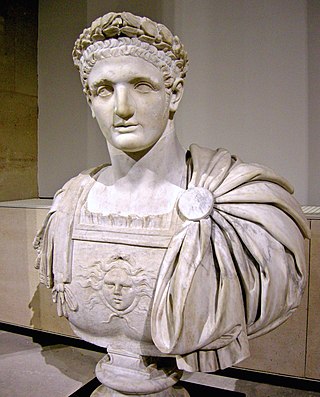
Domitian was Roman emperor from 81 to 96. The son of Vespasian and the younger brother of Titus, his two predecessors on the throne, he was the last member of the Flavian dynasty. Described as "a ruthless but efficient autocrat", his authoritarian style of ruling put him at sharp odds with the Senate, whose powers he drastically curtailed.

Roman law is the legal system of ancient Rome, including the legal developments spanning over a thousand years of jurisprudence, from the Twelve Tables, to the Corpus Juris Civilis ordered by Eastern Roman emperor Justinian I.

The 90s was a decade that ran from January 1, AD 90, to December 31, AD 99.

Titus Caesar Vespasianus was Roman emperor from 79 to 81. A member of the Flavian dynasty, Titus succeeded his father Vespasian upon his death, becoming the first Roman emperor ever to succeed his biological father.
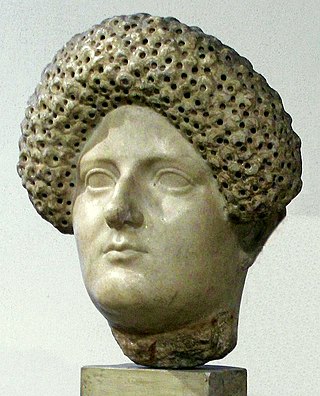
Domitia Longina was a Roman empress and wife to the Roman emperor Domitian. She was the youngest daughter of the general and consul Gnaeus Domitius Corbulo. Domitia divorced her first husband, Lucius Aelius Lamia Plautius Aelianus in order to marry Domitian in AD 71. The marriage produced only one son, whose early death is believed to have been the cause of a temporary rift between Domitia and her husband in 83. She became the empress upon Domitian's accession in 81, and remained so until his assassination in 96. She is believed to have died sometime between AD 126 and 130.
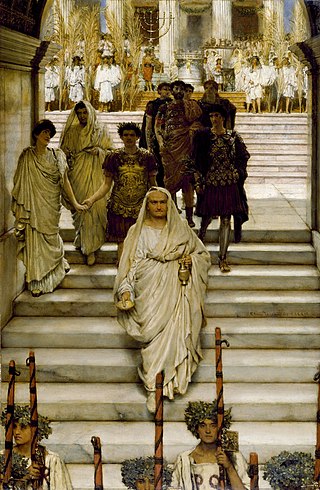
The Flavian dynasty, lasting from 69 to 96 CE, was the second dynastic line of emperors to rule the Roman Empire following the Julio-Claudians, encompassing the reigns of Vespasian and his two sons, Titus and Domitian. The Flavians rose to power during the civil war of 69 CE, known as the Year of the Four Emperors; after Galba and Otho died in quick succession, Vitellius became emperor in mid 69. His claim to the throne was quickly challenged by legions stationed in the eastern provinces, who declared their commander Vespasian emperor in his place. The Second Battle of Bedriacum tilted the balance decisively in favor of the Flavian forces, who entered Rome on 20 December, and the following day, the Roman Senate officially declared Vespasian emperor, thus commencing the Flavian dynasty. Although the dynasty proved to be short-lived, several significant historic, economic and military events took place during their reign.

Citizenship in ancient Rome was a privileged political and legal status afforded to free individuals with respect to laws, property, and governance. Citizenship in ancient Rome was complex and based upon many different laws, traditions, and cultural practices. There existed several different types of citizenship, determined by one's gender, class, and political affiliations, and the exact duties or expectations of a citizen varied throughout the history of the Roman Empire.
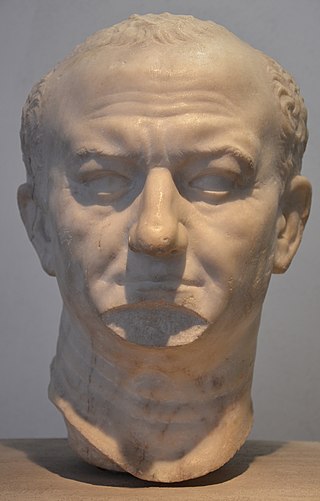
The gens Flavia was a plebeian family at ancient Rome. Its members are first mentioned during the last three centuries of the Republic. The first of the Flavii to achieve prominence was Marcus Flavius, tribune of the plebs in 327 and 323 BC; however, no Flavius attained the consulship until Gaius Flavius Fimbria in 104 BC. The gens became illustrious during the first century AD, when the family of the Flavii Sabini claimed the imperial dignity.

The duumviri, originally duoviri and also known in English as the duumvirs, were any of various joint magistrates of ancient Rome. Such pairs of Roman magistrates were appointed at various periods of Roman history both in Rome itself and in the colonies and municipia.

Flavia Domitilla Major was the wife of the Roman Emperor Vespasian and mother of the emperors Titus and Domitian. She died before her husband became emperor in 69 AD. After her death she is thought to have been deified by the name Diva Domitilla.
Flavia Domitilla was a Roman noblewoman of the 1st century AD. She was a granddaughter of Emperor Vespasian and a niece of Emperors Titus and Domitian. She married her second cousin, the consul Titus Flavius Clemens, a grand-nephew of Vespasian through his father Titus Flavius Sabinus.

Ius Italicum or ius italicum was a law in the early Roman Empire that allowed the emperors to grant cities outside Italy the legal fiction that they were on Italian soil. This meant that the city would be governed under Roman law rather than local law, and it would have a greater degree of autonomy in their relations with provincial governors. As Roman citizens, people were able to buy and sell property, were exempt from land tax and the poll tax, and were entitled to protection under Roman law. Ius Italicum was the highest liberty a municipality or province could obtain and was considered very favorable. Emperors, such as Augustus and Septimius Severus, made use of the law during their reign.

The Lex Ursonensis is the foundation charter of the Caesarean colonia Iulia Genetiva at Urso near Osuna in southern Spain. A copy of its text was inscribed on bronze under the Flavians, portions of which were discovered in 1870/71. The original law spanned nine tablets with three or five columns of text each and comprised over 140 sections (rubricae). Of these four tablets survive, including sections 61-82, 91-106 and 123-134. Remains are kept in the National Archaeological Museum of Spain, in Madrid.

Álvaro Jordi d'Ors Pérez-Peix was a Spanish scholar of Roman law, currently considered one of the best 20th-century experts on the field; he served as professor at the universities of Santiago de Compostela and Pamplona. He was also theorist of law and political theorist, responsible for development of Traditionalist vision of state and society. Politically he supported the Carlist cause. Though he did not hold any official posts within the organization, he counted among top intellectuals of the movement; he was member of the advisory council of the Carlist claimant.
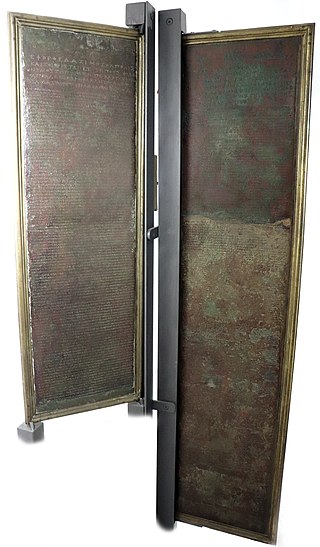
The Heraclean Tablets are bronze tablets found a short distance from the site of Heraclea Lucania, in the direction of Metapontum. They are significant for the study of Roman Law.

The Palace of Domitian was built as Roman emperor Domitian's official residence in 81–92 AD and was used as such by subsequent emperors. Its remains sit atop and dominate Palatine Hill in Rome, alongside other palaces.
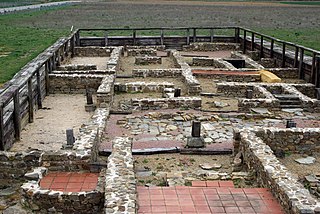
Petavonium was a Roman Legionary Fortress (castrum) of the Legio X Gemina, and later a Roman city formed from the canabae, or civilian camp. It was located in the valley of Vidriales in an area of the modern Santibanez de Vidriales and its hamlet Rosinos de Vidriales, in the province of Zamora.
(Lucius?) Plotius Pegasus was a Roman senator and jurisconsult active under the Flavian dynasty. He was suffect consul in an uncertain year, most likely 72 or 73, as the colleague of Lucius Cornelius Pusio Annius Messalla. Shortly after his ascension to the imperial throne, Domitian appointed Pegasus urban prefect, one of the most prestigious offices in a senatorial career.
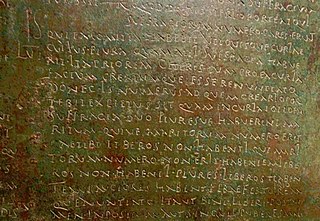
Lex Malacitana or Lex Flavia Malacitana is a bronze tablet bearing Latin local statutes which deal with the official activities of the duoviri iuri dicundo. The tablet was found in the 20th century near Malaca with the lex Salpensana, and it was dated from AD 81–84, i.e. the early reign of Domitian. Malaca was governed under this law, which granted free-born persons the privileges of Roman citizenship.

The ancient Roman Villa of Domitian is located on the shore of the lagoon of Paola between Sabaudia and San Felice Circeo, Italy, at a locality known as Palazzo. It was one of the palaces that belonged to the emperor Domitian, and which he called his villa "at Circeii". It is considered one of the most important yet little-known Roman imperial residences in Latium.
References
- 1 2 3 4 5 6 7 8 9 "Lex Irnitana, Encyclopedia of Ancient History"
- 1 2 3 4 5 6 7 8 "The lex Irnitina, a new copy of Flavian Municipal Law", Julian Gonzales
- ↑ Das römische Zivilprozessrecht, Kaser, Beck, 1996
- ↑ "The lex Irnitana and procedure in the civil courts", A. Rodger
- 1 2 3 "Agree to Disagree: Local Jurisdiction in the lex Irnitana", Ernest Metzger
- ↑ D'Ors 1983, p. 7.
- ↑ González 2012, p. 156
- ↑ D'Ors 1983, p. 11.